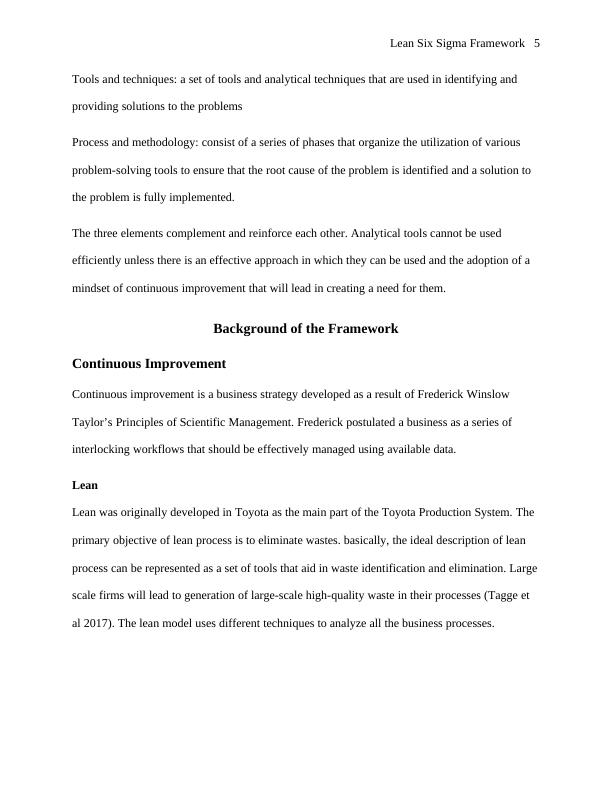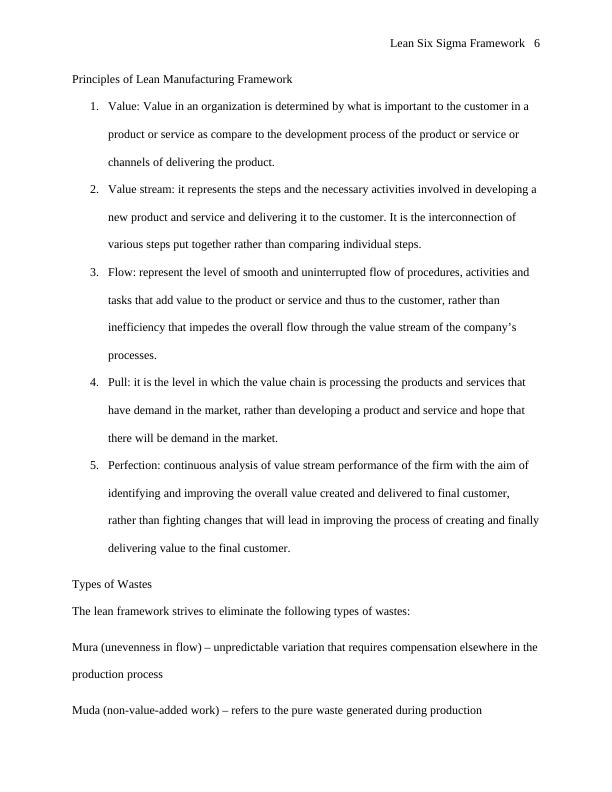Assignment on Lean Six Sigma Framework.
Develop a unique conceptual Operational Excellence Assessment model for the pharmaceutical industry.
23 Pages5026 Words24 Views
Added on 2022-09-25
About This Document
Follow the instructions in the assignment guide 1254912 similar
Assignment on Lean Six Sigma Framework.
Develop a unique conceptual Operational Excellence Assessment model for the pharmaceutical industry.
Added on 2022-09-25
ShareRelated Documents
Lean Six Sigma Framework 1
Lean Six sigma Framework
Student’s Name
Professor
Date
Lean Six sigma Framework
Student’s Name
Professor
Date

Lean Six Sigma Framework 2
Contents
Overview..........................................................................................................................................4
Elements of the Framework.........................................................................................................4
Background of the Framework........................................................................................................5
Continuous Improvement............................................................................................................5
Lean.........................................................................................................................................5
Six Sigma.................................................................................................................................7
Similarity and Differences.......................................................................................................8
The Lean Six Sigma Principles......................................................................................................10
Addressing real world problems................................................................................................10
Analysis of the methodology is accomplished by the team.......................................................10
Analysis is majorly focused on the process...............................................................................10
Process analysis in dependent on data.......................................................................................10
Solutions of the model address the root cause of the problem..................................................11
The solution proposed includes a control system that helps it stick..........................................11
Benefits of lean six sigma..........................................................................................................11
organizational benefits...........................................................................................................12
Personal Benefits...................................................................................................................14
Contents
Overview..........................................................................................................................................4
Elements of the Framework.........................................................................................................4
Background of the Framework........................................................................................................5
Continuous Improvement............................................................................................................5
Lean.........................................................................................................................................5
Six Sigma.................................................................................................................................7
Similarity and Differences.......................................................................................................8
The Lean Six Sigma Principles......................................................................................................10
Addressing real world problems................................................................................................10
Analysis of the methodology is accomplished by the team.......................................................10
Analysis is majorly focused on the process...............................................................................10
Process analysis in dependent on data.......................................................................................10
Solutions of the model address the root cause of the problem..................................................11
The solution proposed includes a control system that helps it stick..........................................11
Benefits of lean six sigma..........................................................................................................11
organizational benefits...........................................................................................................12
Personal Benefits...................................................................................................................14

Lean Six Sigma Framework 3
Lean six sigma belts.......................................................................................................................15
Yellow belt.................................................................................................................................15
Green belt...................................................................................................................................16
Black belt...................................................................................................................................16
master black belt........................................................................................................................17
Phases of Lean Six Sigma Model – DMAIC.................................................................................18
Definition of lean six sigma DMAIC........................................................................................18
Phase 1: Define......................................................................................................................18
Phase 2: Measure...................................................................................................................19
Phase 3: Analyze....................................................................................................................19
Phase 4: Improve...................................................................................................................19
Phase 5: Control.....................................................................................................................19
Lean six sigma tools and techniques.............................................................................................19
Process analysis tools................................................................................................................20
FDA Drug Recall Solution Using the Model................................................................................21
application of the model............................................................................................................21
References......................................................................................................................................22
Lean six sigma belts.......................................................................................................................15
Yellow belt.................................................................................................................................15
Green belt...................................................................................................................................16
Black belt...................................................................................................................................16
master black belt........................................................................................................................17
Phases of Lean Six Sigma Model – DMAIC.................................................................................18
Definition of lean six sigma DMAIC........................................................................................18
Phase 1: Define......................................................................................................................18
Phase 2: Measure...................................................................................................................19
Phase 3: Analyze....................................................................................................................19
Phase 4: Improve...................................................................................................................19
Phase 5: Control.....................................................................................................................19
Lean six sigma tools and techniques.............................................................................................19
Process analysis tools................................................................................................................20
FDA Drug Recall Solution Using the Model................................................................................21
application of the model............................................................................................................21
References......................................................................................................................................22

Lean Six Sigma Framework 4
Overview
Lean Six Sigma is a model designed to improve processes by eliminating problems,
inefficiencies, wastes, and improving the working conditions in order to provide the desired
response to the needs of the customers. The model combines various tools, principles, and
methods of six sigma and lean-to form one robust methodology in improving overall operations
in the organization (Shah et al., 2019). The framework has a team-oriented approach that has a
proven outcome in its application in maximizing operations efficiencies and promptly improving
profitability for organizations.
Elements of the Framework
Mindset and culture: it fosters a way of thinking that is dependent on data and the processes to
realize operational performance objectives and continuous improvement
Overview
Lean Six Sigma is a model designed to improve processes by eliminating problems,
inefficiencies, wastes, and improving the working conditions in order to provide the desired
response to the needs of the customers. The model combines various tools, principles, and
methods of six sigma and lean-to form one robust methodology in improving overall operations
in the organization (Shah et al., 2019). The framework has a team-oriented approach that has a
proven outcome in its application in maximizing operations efficiencies and promptly improving
profitability for organizations.
Elements of the Framework
Mindset and culture: it fosters a way of thinking that is dependent on data and the processes to
realize operational performance objectives and continuous improvement

Lean Six Sigma Framework 5
Tools and techniques: a set of tools and analytical techniques that are used in identifying and
providing solutions to the problems
Process and methodology: consist of a series of phases that organize the utilization of various
problem-solving tools to ensure that the root cause of the problem is identified and a solution to
the problem is fully implemented.
The three elements complement and reinforce each other. Analytical tools cannot be used
efficiently unless there is an effective approach in which they can be used and the adoption of a
mindset of continuous improvement that will lead in creating a need for them.
Background of the Framework
Continuous Improvement
Continuous improvement is a business strategy developed as a result of Frederick Winslow
Taylor’s Principles of Scientific Management. Frederick postulated a business as a series of
interlocking workflows that should be effectively managed using available data.
Lean
Lean was originally developed in Toyota as the main part of the Toyota Production System. The
primary objective of lean process is to eliminate wastes. basically, the ideal description of lean
process can be represented as a set of tools that aid in waste identification and elimination. Large
scale firms will lead to generation of large-scale high-quality waste in their processes (Tagge et
al 2017). The lean model uses different techniques to analyze all the business processes.
Tools and techniques: a set of tools and analytical techniques that are used in identifying and
providing solutions to the problems
Process and methodology: consist of a series of phases that organize the utilization of various
problem-solving tools to ensure that the root cause of the problem is identified and a solution to
the problem is fully implemented.
The three elements complement and reinforce each other. Analytical tools cannot be used
efficiently unless there is an effective approach in which they can be used and the adoption of a
mindset of continuous improvement that will lead in creating a need for them.
Background of the Framework
Continuous Improvement
Continuous improvement is a business strategy developed as a result of Frederick Winslow
Taylor’s Principles of Scientific Management. Frederick postulated a business as a series of
interlocking workflows that should be effectively managed using available data.
Lean
Lean was originally developed in Toyota as the main part of the Toyota Production System. The
primary objective of lean process is to eliminate wastes. basically, the ideal description of lean
process can be represented as a set of tools that aid in waste identification and elimination. Large
scale firms will lead to generation of large-scale high-quality waste in their processes (Tagge et
al 2017). The lean model uses different techniques to analyze all the business processes.

Lean Six Sigma Framework 6
Principles of Lean Manufacturing Framework
1. Value: Value in an organization is determined by what is important to the customer in a
product or service as compare to the development process of the product or service or
channels of delivering the product.
2. Value stream: it represents the steps and the necessary activities involved in developing a
new product and service and delivering it to the customer. It is the interconnection of
various steps put together rather than comparing individual steps.
3. Flow: represent the level of smooth and uninterrupted flow of procedures, activities and
tasks that add value to the product or service and thus to the customer, rather than
inefficiency that impedes the overall flow through the value stream of the company’s
processes.
4. Pull: it is the level in which the value chain is processing the products and services that
have demand in the market, rather than developing a product and service and hope that
there will be demand in the market.
5. Perfection: continuous analysis of value stream performance of the firm with the aim of
identifying and improving the overall value created and delivered to final customer,
rather than fighting changes that will lead in improving the process of creating and finally
delivering value to the final customer.
Types of Wastes
The lean framework strives to eliminate the following types of wastes:
Mura (unevenness in flow) – unpredictable variation that requires compensation elsewhere in the
production process
Muda (non-value-added work) – refers to the pure waste generated during production
Principles of Lean Manufacturing Framework
1. Value: Value in an organization is determined by what is important to the customer in a
product or service as compare to the development process of the product or service or
channels of delivering the product.
2. Value stream: it represents the steps and the necessary activities involved in developing a
new product and service and delivering it to the customer. It is the interconnection of
various steps put together rather than comparing individual steps.
3. Flow: represent the level of smooth and uninterrupted flow of procedures, activities and
tasks that add value to the product or service and thus to the customer, rather than
inefficiency that impedes the overall flow through the value stream of the company’s
processes.
4. Pull: it is the level in which the value chain is processing the products and services that
have demand in the market, rather than developing a product and service and hope that
there will be demand in the market.
5. Perfection: continuous analysis of value stream performance of the firm with the aim of
identifying and improving the overall value created and delivered to final customer,
rather than fighting changes that will lead in improving the process of creating and finally
delivering value to the final customer.
Types of Wastes
The lean framework strives to eliminate the following types of wastes:
Mura (unevenness in flow) – unpredictable variation that requires compensation elsewhere in the
production process
Muda (non-value-added work) – refers to the pure waste generated during production

End of preview
Want to access all the pages? Upload your documents or become a member.
Related Documents
Lean Six Sigma in Industrieslg...
|18
|6773
|460
Improving Healthcare Referral System Using Lean Six Sigmalg...
|12
|551
|227
Business Process Management: Lean, Six Sigma and BPMlg...
|5
|939
|392
King Abdullah Medical City (KAMC) Assignmentlg...
|12
|1690
|79
Management Tool for King Abdullah Medical Citylg...
|7
|460
|209
Implementing Six Sigma for Quality Program at Kortilidon Koti Companylg...
|12
|2924
|36
